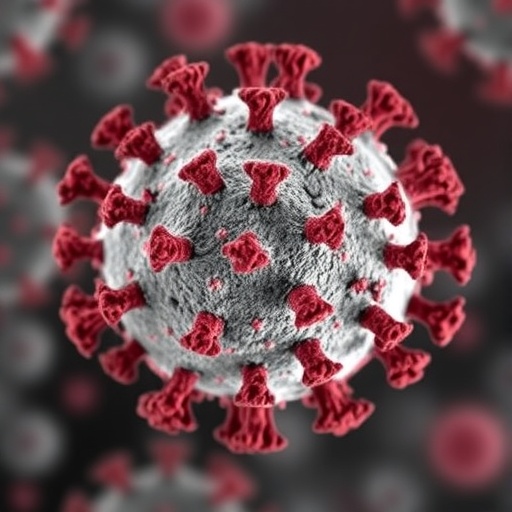In a groundbreaking advancement in antiviral research, scientists have unveiled a nanobody that specifically targets the prefusion conformation of glycoprotein B (gB) in herpes simplex viruses, demonstrating exceptional binding affinity and cross-species neutralization potential. This discovery paves the way for novel therapeutic strategies against HSV-1 and HSV-2, two pervasive human pathogens notorious for causing lifelong infections and recurrent disease manifestations.
Glycoprotein B, a key viral envelope protein, is indispensable for herpesvirus entry into host cells, mediating membrane fusion during viral infection. Its dynamic structural rearrangements, shifting between prefusion and postfusion conformations, have historically complicated efforts to design effective inhibitors. Researchers have now illuminated this challenging target by isolating a nanobody, Nb1_gbHSV, that exhibits a striking preference for the prefusion form, a conformation transiently adopted during the virus’s entry process.
High-resolution cryo-electron microscopy of gB bound by Nb1_gbHSV revealed a detailed interaction landscape. The nanobody engages simultaneously with three distinct domains on gB, namely Di, Diii, and Div. This multifunctional engagement is stabilised through an extraordinary network of 23 hydrogen bonds and eight salt bridges, resulting in an extensive buried surface area measuring approximately 1,260 Ų. Such intimate molecular interactions underscore the nanobody’s formidable binding affinity.
Residue R102 on Nb1_gbHSV plays a pivotal role, protruding into the interface between Div and Di to form additional hydrogen bonds with Di and Diii of the same protomer. This precise targeting is significant because Di and Div reside in proximity only in the prefusion conformation; in the postfusion state, these domains are widely separated. Consequently, the nanobody’s epitope is structurally accessible solely in the prefusion form, conferring a remarkable degree of conformation specificity.
Functional assays substantiated the nanobody’s selective affinity, with microscale thermophoresis revealing a dissociation constant (KD) around an extraordinarily low 14 picomolar for prefusion gB, whereas no measurable binding occurred with the postfusion form. This demonstrates the nanobody’s potential to act as a prefusion-specific antagonist, a critical advantage as viral fusion proteins often evade neutralization by transitioning to postfusion states.
Cross-reactivity assays provided further excitement, as Nb1_gbHSV was found to bind gB from both HSV-1 and HSV-2. Despite low conservation of the epitope among other human-infecting herpesviruses such as varicella-zoster virus (VZV), cytomegalovirus (HCMV), and Epstein-Barr virus (EBV), the nanobody’s binding to HSV-2 gB is likely underpinned by the high sequence similarity in this region between HSV-1 and HSV-2. This cross-species reactivity enhances the therapeutic promise of Nb1_gbHSV.
Cellular localization experiments using fluorescently labelled Nb1_gbHSV confirmed the nanobody’s ability to bind gB expressed on the plasma membrane of transfected baby hamster kidney (BHK-21) cells. Co-localization with green fluorescent protein tags on gB reinforced these findings, with evidence suggesting rapid internalization of the nanobody-gB complex via endocytosis. This internal trafficking indicates the nanobody does not interrupt native cellular machinery, a critical consideration for therapeutic applications that require minimal off-target effects.
Structural modeling further supports the prefusion-specific nature of Nb1_gbHSV. When computationally docked onto the postfusion conformation of gB, the nanobody induces steric clashes between domains, particularly Div and Di of adjacent protomers, implicating an unstable interaction. This implies that Nb1_gbHSV likely stabilizes the prefusion form, preventing the conformational changes necessary for viral membrane fusion, thus neutralizing viral infectivity.
This discovery marks a significant milestone in the development of nanobody-based therapeutics against herpesviruses. Nanobodies, due to their small size and stability, offer distinct advantages over conventional antibodies, including higher tissue penetration and ease of manufacturing. The selective targeting of a metastable prefusion state presents a compelling antiviral approach, potentially limiting viral spread and ameliorating disease severity.
Moreover, the detailed characterization of the Nb1_gbHSV binding interface opens avenues for rational drug design. Small molecules or engineered biologics mimicking this interface could be developed to enhance the antiviral arsenal against herpesviruses. Additionally, the unique epitopic site defined by the proximity of Di and Div domains provides a blueprint for future vaccines aimed at eliciting broadly neutralizing antibodies against HSV-1 and HSV-2.
The research also underscores the importance of nanobody technology in virology. By exploiting their unique binding modalities and conformational selectivity, nanobodies can illuminate viral protein dynamics and provide effective means to disrupt viral life cycles. Nb1_gbHSV exemplifies this potential, evidencing high specificity without compromising cellular functions such as endocytosis, a balance essential for safe therapeutic application.
As HSV remains a significant global health burden — with tens of millions affected worldwide, and complications ranging from painful mucocutaneous lesions to neuroinvasive diseases — the emergence of such innovative molecular tools is urgently needed. Nb1_gbHSV’s ability to differentiate viral conformations and cross-react with multiple HSV species suggests a versatile template for future antiviral therapies that could surpass current treatment limitations.
Continuing structural and functional analyses are anticipated to further clarify the mechanisms by which Nb1_gbHSV exerts viral neutralization in vivo. Future studies will also explore its therapeutic efficacy, pharmacodynamics, and potential integration into clinical regimens. The promise of neutralizing gB at its prefusion conformation heralds a new frontier for vaccines and biologics against herpes simplex viruses.
In summary, Nb1_gbHSV represents a transformative breakthrough in herpesvirus research, epitomizing the intersection of structural biology, immunology, and nanobody engineering. By harnessing prefusion specificity and cross-species reactivity, this molecule exemplifies next-generation antiviral strategies poised to mitigate the global impact of HSV infections.
Subject of Research: Nanobody-mediated neutralization of herpes simplex virus glycoprotein B prefusion conformation
Article Title: A nanobody specific to prefusion glycoprotein B neutralizes HSV-1 and HSV-2
Article References:
Vollmer, B., Ebel, H., Rees, R. et al. A nanobody specific to prefusion glycoprotein B neutralizes HSV-1 and HSV-2. Nature (2025). https://doi.org/10.1038/s41586-025-09438-5




